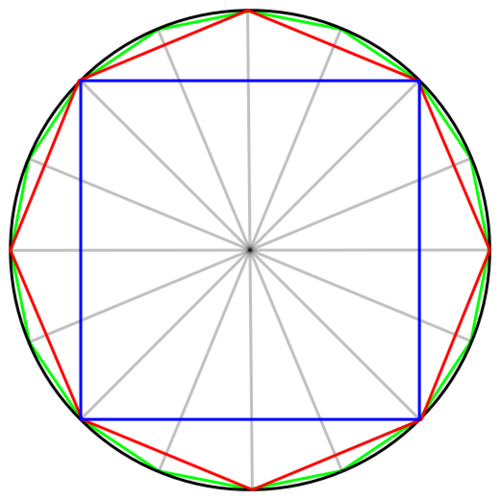Common Vertices
 Two regular polygons are inscribed in the same circle. The first polygon has 1982 sides and second has 2973 sides. If the polygons have common vertices , the number of such vertices is
__________
.
Two regular polygons are inscribed in the same circle. The first polygon has 1982 sides and second has 2973 sides. If the polygons have common vertices , the number of such vertices is
__________
.
This section requires Javascript.
You are seeing this because something didn't load right. We suggest you, (a) try
refreshing the page, (b) enabling javascript if it is disabled on your browser and,
finally, (c)
loading the
non-javascript version of this page
. We're sorry about the hassle.
12 solutions
Assume that an integral number of sides (say y ) of the 2 9 7 3 -gon and integral number (say x ) of the 1 9 8 2 -gon will subtend an equal angle at the center of the circle. Now, one side of the 2 9 7 3 -gon will subtend 2 9 7 3 3 6 0 degrees, so y sides will obviously subtend 2 9 7 3 3 6 0 y degrees. Similarly the other polygon will subtend 1 9 8 2 3 6 0 x degrees.
Now remember what we said about the respective number of sides of the polygon (obviously both regular) subtending equal angles at the center? Yeah. Just equate the angles we just got, that is θ = 2 9 7 3 3 6 0 y = 1 9 8 2 3 6 0 x . You get the least integral solution to be something on the lines of y = 3 and x = 2 (so yeah, that's like many of the GCD-solutions in the comments here).
Now we're almost done. Just divide the respective polygons' number of sides by y or x . Either way you get y 2 9 7 3 = x 1 9 8 2 = 9 9 1 . And that's your answer.
I do have one doubt though - won't the last coinciding vertex be the same as the first one? Answer should be 9 9 0 then.
Log in to reply
Nope the 2973 polygon when div by 3 gives us unique triplets .... We can assume that the first vertex in the first triplet matches with the vertex of the other polygon .. Think carefully and you will understand that the first vertex of each triplet will give a common vertex hence 991 unique common vertices ....
let N1=1982 N2=2973 and here angle at vertex of a triangle formed by centre of the circle is given by Nc1=(360/1982) and Nc2=(360/2973) and by taking the ratio Nc1:Nc2=2:3 which means for every three vertices of larger poygon or for every two sides of smaller polygin there will be common vertex so the answer is (1982/2)=(2973/3)=991
To find the common vertices i just find out the greatest integer of 1982 and 2973 and got the ans without considering the no of common roots and all....nyways good sum!
Log in to reply
U can try this sum also ... " 3 Concentric spherical shells "
Log in to reply
i tried but somewhere went wrong! i have to rethink abt it.
Yeah ultimately I mentioned so... I wrote the actual process... I came across this sum today... well greatest integer between them , I didn't get u!
Log in to reply
sorry it will b greatest common divisor! :P i wrote wrong!
Until and unless it is given that one vertex is the same for both polygons, the solution shall stand invalid
just 2973-1982= 991
Log in to reply
wrong logic..!
Totally wrong man ...
let N1=1982 N2=2973 and here angle at vertex of a triangle formed by centre of the circle is given by Nc1=(360/1982) and Nc2=(360/2973) and by taking the ratio Nc1:Nc2=2:3 which means for every three vertices of larger poygon or for every two sides of smaller polygin there will be common vertex so the answer is (1982/2)=(2973/3)=991
GCD of 1982 & 2973 is 991, so 991 will be ryte ans.
The common factor in both polygons of 1982 and 2973 are (2X991 and 3X991) so number of vetices will be 991 Ans
K.K.GARG,India
t N1=1982 N2=2973 and here angle at vertex of a triangle formed by centre of the circle is given by Nc1=(360/1982) and Nc2=(360/2973) and by taking the ratio Nc1:Nc2=2:3 which means for every three vertices of larger poygon or for every two sides of smaller polygin there will be common vertex so the answer is (1982/2)=(2973/3)=991
If you have a square and an octagon you get 4 common vertices but if you have a square and an an hexagon you get 2 common vertices, the half of the smaller number and the relation between 4 and 6 is 1.5 same as 1982 and 2973 so the answer is the half of the smaller number: 1982/2= 991
If there is something wrong with the way I write or the words I use is because I don't speak English pretty well ;P
2973-1982=991,hey its too easy....
what type of logic is this ???
the central angle of the polygon is 360/2973 for the next polygon central angle is 360/1982 so for both we get 991 as the denominator
The number of vertices is the number of sides , (2973/1892=1.5) that's mean it takes 3 vertices of the big polygon to coincide with one vertex of the small one so (2973/3=991)
2973-1982=991...hence its the ans.!! easy ..
@Anuj Kushwah , Will it be applicable for all situations
wrong logic
The number of common vertices is equal to the number of common roots of the equation z^1982 - 1=0 and z^2973 - 1 = 0 , which is GCD of (1982,2973)..... hence 991 is the answer !